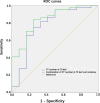Dual-energy spectral CT characteristics in surgically resected lung adenocarcinoma: comparison between Kirsten rat sarcoma viral oncogene mutations and epidermal growth factor receptor mutations
- PMID: 31783917
- PMCID: PMC6884869
- DOI: 10.1186/s40644-019-0261-1
Dual-energy spectral CT characteristics in surgically resected lung adenocarcinoma: comparison between Kirsten rat sarcoma viral oncogene mutations and epidermal growth factor receptor mutations
Abstract
Background: Kirsten rat sarcoma viral oncogene homolog (KRAS) and epidermal growth factor receptor (EGFR) are the two most frequent and well-known oncogene of lung adenocarcinoma. The purpose of this study is to compare the characteristics measured with dual-energy spectral computed tomography (DESCT) in lung adenocarcinoma patients who have KRAS and EGFR gene mutations.
Methods: Patients with surgically resected lung adenocarcinoma (n = 72) were enrolled, including 12 patients with KRAS mutations and 60 patients with EGFR mutations. DESCT quantitative parameters, including the CT number at 70 keV, the slopes of the spectral attenuation curves (slope λ HU), normalized iodine concentration (NIC), normalized water concentration (NWC), and effective atomic number (effective Z), were analyzed. A multiple logistic regression model was applied to discriminate clinical and DESCT characteristics between the types of mutations.
Results: The KRAS mutation was more common in people who smoked than the EGFR mutation. Nodule type differed significantly between the KRAS and EGFR groups (P = 0.035), and all KRAS mutation adenocarcinomas were solid nodules. Most DESCT quantitative parameters differed significantly between solid nodules and subsolid nodules. CT number at 70 keV, slope λ HU, NIC, and effective Z differed significantly between the KRAS and EGFR groups (P = 0.006, 0.017, 0.013 and 0.010) with solid lung adenocarcinoma. Multivariate logistic analysis of DESCT and clinical features indicated that besides smoking history, the CT value at 70 keV (OR = 0.938, P = 0.009) was significant independent factor that could be used to differentiate KRAS and EGFR mutations in solid lung adenocarcinoma.
Conclusions: DESCT would be a potential tool to differentiate lung adenocarcinoma patients with a KRAS mutation from those with an EGFR mutation.
Keywords: Adenocarcinoma of lung; Dual-energy spectral computed tomography; EGFR mutation; KRAS mutation; Solid nodule; Subsolid nodule.
Conflict of interest statement
The authors declare that they have no competing interests.
Figures




Similar articles
-
Identification of epidermal growth factor receptor mutations in pulmonary adenocarcinoma using dual-energy spectral computed tomography.Eur Radiol. 2019 Jun;29(6):2989-2997. doi: 10.1007/s00330-018-5756-9. Epub 2018 Oct 26. Eur Radiol. 2019. PMID: 30367185
-
Comparison of CT radiogenomic and clinical characteristics between EGFR and KRAS mutations in lung adenocarcinomas.Clin Radiol. 2018 Jun;73(6):590.e1-590.e8. doi: 10.1016/j.crad.2018.01.009. Epub 2018 Feb 14. Clin Radiol. 2018. PMID: 29454587 Clinical Trial.
-
Quantitative features of dual-energy spectral computed tomography for solid lung adenocarcinoma with EGFR and KRAS mutations, and ALK rearrangement: a preliminary study.Transl Lung Cancer Res. 2019 Aug;8(4):401-412. doi: 10.21037/tlcr.2019.08.13. Transl Lung Cancer Res. 2019. PMID: 31555515 Free PMC article.
-
Molecular typing of lung adenocarcinoma with computed tomography and CT image-based radiomics: a narrative review of research progress and prospects.Transl Cancer Res. 2021 Sep;10(9):4217-4231. doi: 10.21037/tcr-21-1037. Transl Cancer Res. 2021. PMID: 35116717 Free PMC article. Review.
-
The nonsmokers' and smokers' pathways in lung adenocarcinoma: Histological progression and molecular bases.Cancer Sci. 2021 Sep;112(9):3411-3418. doi: 10.1111/cas.15031. Epub 2021 Jul 11. Cancer Sci. 2021. PMID: 34143937 Free PMC article. Review.
Cited by
-
Unveiling diagnostic biomarkers and therapeutic targets in lung adenocarcinoma using bioinformatics and experimental validation.Sci Rep. 2025 Jul 2;15(1):22893. doi: 10.1038/s41598-025-05227-2. Sci Rep. 2025. PMID: 40595823 Free PMC article.
-
Enhancing the prediction of KRAS mutation status in Asian lung adenocarcinoma: a comprehensive approach combining clinical, dual-energy spectral computed tomography, and radiomics features.Transl Lung Cancer Res. 2024 Dec 31;13(12):3566-3578. doi: 10.21037/tlcr-24-694. Epub 2024 Dec 27. Transl Lung Cancer Res. 2024. PMID: 39830763 Free PMC article.
-
Intratumoral and peritumoral CT radiomics in predicting anaplastic lymphoma kinase mutations and survival in patients with lung adenocarcinoma: a multicenter study.Cancer Imaging. 2025 Mar 13;25(1):35. doi: 10.1186/s40644-025-00856-2. Cancer Imaging. 2025. PMID: 40083024 Free PMC article.
-
Iodine-related attenuation in contrast-enhanced dual-energy computed tomography in small-sized solid-type lung cancers is associated with the postoperative prognosis.Cancer Imaging. 2021 Jan 7;21(1):7. doi: 10.1186/s40644-020-00368-1. Cancer Imaging. 2021. PMID: 33413669 Free PMC article.
References
-
- Bray F, Ferlay J, Soerjomataram I, Siegel RL, Torre LA, Jemal A. Global cancer statistics 2018: GLOBOCAN estimates of incidence and mortality worldwide for 36 cancers in 185 countries. CA Cancer J Clin. 2018. - PubMed
-
- Lynch TJ, Bell DW, Sordella R, Gurubhagavatula S, Okimoto RA, Brannigan BW, Harris PL, Haserlat SM, Supko JG, Haluska FG, et al. Activating mutations in the epidermal growth factor receptor underlying responsiveness of non-small-cell lung cancer to gefitinib. N Engl J Med. 2004;350(21):2129–2139. doi: 10.1056/NEJMoa040938. - DOI - PubMed
Publication types
MeSH terms
Substances
Grants and funding
LinkOut - more resources
Full Text Sources
Medical
Research Materials
Miscellaneous

